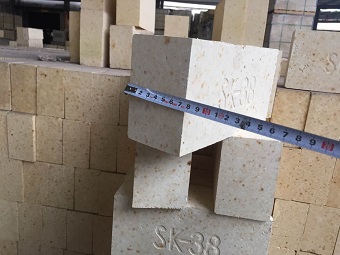Types of aluminum silicate refractories
Apr 07, 2022
Aluminum silicate refractory is composed of Al2O3 and SiO2 and a small amount of impurities. According to the different alumina contained in it, it can be divided into:
Semi-silica bricks (semi-acid bricks) contain Al2O3 15-30%;
Clay bricks contain Al2O330~46%;
High alumina bricks contain Al2O3>46%;
Aluminum silicate refractories are rich in resources and low in cost, especially clay bricks are widely used.
Aluminum silicate refractories are rich in resources and low in cost, especially clay bricks are widely used.
Clay bricks
1. Composition of clay bricks:
It contains Al2O3 30~46%, SiO250~65%, and also contains a small amount of alkali metal and alkaline earth metal oxides.
Clay bricks are made of refractory clay calcined clinker as a barren agent (the clay has been fully shrunk after being fully calcined. When it is fired into bricks, there is no significant volume shrinkage), and combined with clay as an adhesive at 1300 ° C ~ Products fired at 1400°C.
2. Properties of clay bricks
(1) Refractoriness:
With the increase of alumina content, the refractoriness of clay bricks also increases.
Special: The refractoriness is not less than 1750℃.
Class 1: The refractoriness is not lower than 1730℃.
Second class: The refractoriness is not lower than 1670℃.
Third class: The refractoriness is not lower than 1580℃.

(2) Load softening point:
The starting temperature of clay brick softening under load is about 1350℃. The reason is that the glass phase contained in the brick causes the softening point temperature under load to be low.
(3) Volume stability:
The use temperature of clay bricks cannot exceed the firing temperature, otherwise the volume will shrink and the masonry brick joints will increase.
(4) Thermal stability:
Clay bricks have good thermal stability because the bricks contain mullite and have a small expansion coefficient. In addition, the brick contains glass phase, which plays a buffering role, so that the stress cannot be developed. It can withstand water cooling 10 times at 850°C.
(5) Slag resistance
Clay bricks contain a certain amount of SiO2 and belong to weak acid refractories, which can resist the erosion of acid slag and have poor resistance to alkali.
3. Theoretical indicators of clay bricks
Clay bricks are widely used, and any masonry without special requirements can be built with clay bricks.
The physical and chemical indicators of clay bricks are shown in the table:
2. Semi-silica brick
The content of SiO2 in semi-silica bricks is more than 65%, and the content of Al2O3 is 15-30%. It is a semi-acid refractory material with the following characteristics:
1. Refractoriness: 1650~1710℃;
2. The thermal stability is worse than that of clay bricks, because it contains SiO2 and has a large expansion coefficient;
3. Softening point under load: 1350~1450℃, slightly higher than ordinary clay bricks;
4. Good volume stability: Because the shrinkage of clay and the expansion of SiO2 can offset each other.
3. High alumina brick
1. Categories of high alumina bricks:
Because of its high alumina content, it is called high alumina refractory material. According to the minerals contained in it, it can be classified as follows:
(1) Mullite (3Al2O3 2SiO2) - silica brick, in which the Al2O3 content is 40-70%.
(2) Mullite-corundum bricks contain 79-95% Al2O3;
(3) Corundum raw material, Al2O3 content is 95-100%. 2.
Performance of high alumina bricks:
(1) High refractoriness: Due to the high content of Al2O3, the refractoriness is generally 1750-1790 °C.
(2) High softening point under load: due to less impurities, the softening point under load is high;
(3) Good slag resistance: Al2O3 content in high alumina bricks is high, which is close to neutral materials.
(4) Good thermal stability: the expansion coefficient of the brick is small.
Relevant information
-

Main properties of magnesium oxide refractory
Performance characteristics of magnesia refractories and other basic refractories Performance characteristics of magnesia refractories and other basic refractories Refractories containing more than 80% ... -

What properties of lightweight insulation fire clay bricks can be improved by the addition of kyanite?
Lightweight insulation fire clay bricks are a kind of shaped refractory material with clay as the main raw material, which is processed, shaped, dried, and calcined with clay. on the kiln. Due to the r ... -

How is the effect of white fused alumina abrasive used in refractory materials?
After mixing, forming, drying, and firing at high temperature in a shuttle kiln. The product has the characteristics of high refractoriness, good thermal shock stability of white corundum, high high te ... -

Characteristics of refractory magnesia chrome bricks for lime kiln
Lime kilns are mainly classified into square kilns and circular kilns. According to the classification of fired products, they can be divided into lime kilns, ceramic kilns, cement kilns, glass kilns, ...

